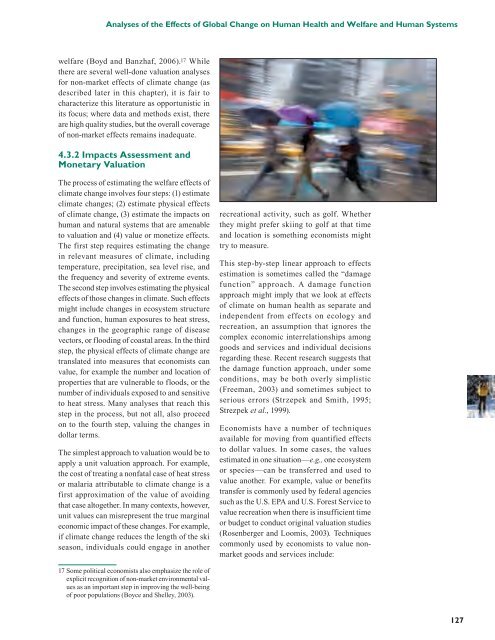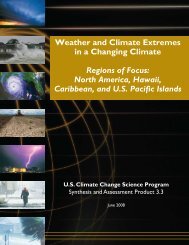Analyses of the Effects of Global Change on - US Climate Change ...
Analyses of the Effects of Global Change on - US Climate Change ...
Analyses of the Effects of Global Change on - US Climate Change ...
Create successful ePaper yourself
Turn your PDF publications into a flip-book with our unique Google optimized e-Paper software.
<str<strong>on</strong>g>Analyses</str<strong>on</strong>g> <str<strong>on</strong>g>of</str<strong>on</strong>g> <str<strong>on</strong>g>the</str<strong>on</strong>g> <str<strong>on</strong>g>Effects</str<strong>on</strong>g> <str<strong>on</strong>g>of</str<strong>on</strong>g> <str<strong>on</strong>g>Global</str<strong>on</strong>g> <str<strong>on</strong>g>Change</str<strong>on</strong>g> <strong>on</strong> Human Health and Welfare and Human Systems<br />
welfare (Boyd and Banzhaf, 2006). 17 While<br />
<str<strong>on</strong>g>the</str<strong>on</strong>g>re are several well-d<strong>on</strong>e valuati<strong>on</strong> analyses<br />
for n<strong>on</strong>-market effects <str<strong>on</strong>g>of</str<strong>on</strong>g> climate change (as<br />
described later in this chapter), it is fair to<br />
characterize this literature as opportunistic in<br />
its focus; where data and methods exist, <str<strong>on</strong>g>the</str<strong>on</strong>g>re<br />
are high quality studies, but <str<strong>on</strong>g>the</str<strong>on</strong>g> overall coverage<br />
<str<strong>on</strong>g>of</str<strong>on</strong>g> n<strong>on</strong>-market effects remains inadequate.<br />
4.3.2 Impacts Assessment and<br />
M<strong>on</strong>etary Valuati<strong>on</strong><br />
The process <str<strong>on</strong>g>of</str<strong>on</strong>g> estimating <str<strong>on</strong>g>the</str<strong>on</strong>g> welfare effects <str<strong>on</strong>g>of</str<strong>on</strong>g><br />
climate change involves four steps: (1) estimate<br />
climate changes; (2) estimate physical effects<br />
<str<strong>on</strong>g>of</str<strong>on</strong>g> climate change, (3) estimate <str<strong>on</strong>g>the</str<strong>on</strong>g> impacts <strong>on</strong><br />
human and natural systems that are amenable<br />
to valuati<strong>on</strong> and (4) value or m<strong>on</strong>etize effects.<br />
The first step requires estimating <str<strong>on</strong>g>the</str<strong>on</strong>g> change<br />
in relevant measures <str<strong>on</strong>g>of</str<strong>on</strong>g> climate, including<br />
temperature, precipitati<strong>on</strong>, sea level rise, and<br />
<str<strong>on</strong>g>the</str<strong>on</strong>g> frequency and severity <str<strong>on</strong>g>of</str<strong>on</strong>g> extreme events.<br />
The sec<strong>on</strong>d step involves estimating <str<strong>on</strong>g>the</str<strong>on</strong>g> physical<br />
effects <str<strong>on</strong>g>of</str<strong>on</strong>g> those changes in climate. Such effects<br />
might include changes in ecosystem structure<br />
and functi<strong>on</strong>, human exposures to heat stress,<br />
changes in <str<strong>on</strong>g>the</str<strong>on</strong>g> geographic range <str<strong>on</strong>g>of</str<strong>on</strong>g> disease<br />
vectors, or flooding <str<strong>on</strong>g>of</str<strong>on</strong>g> coastal areas. In <str<strong>on</strong>g>the</str<strong>on</strong>g> third<br />
step, <str<strong>on</strong>g>the</str<strong>on</strong>g> physical effects <str<strong>on</strong>g>of</str<strong>on</strong>g> climate change are<br />
translated into measures that ec<strong>on</strong>omists can<br />
value, for example <str<strong>on</strong>g>the</str<strong>on</strong>g> number and locati<strong>on</strong> <str<strong>on</strong>g>of</str<strong>on</strong>g><br />
properties that are vulnerable to floods, or <str<strong>on</strong>g>the</str<strong>on</strong>g><br />
number <str<strong>on</strong>g>of</str<strong>on</strong>g> individuals exposed to and sensitive<br />
to heat stress. Many analyses that reach this<br />
step in <str<strong>on</strong>g>the</str<strong>on</strong>g> process, but not all, also proceed<br />
<strong>on</strong> to <str<strong>on</strong>g>the</str<strong>on</strong>g> fourth step, valuing <str<strong>on</strong>g>the</str<strong>on</strong>g> changes in<br />
dollar terms.<br />
The simplest approach to valuati<strong>on</strong> would be to<br />
apply a unit valuati<strong>on</strong> approach. For example,<br />
<str<strong>on</strong>g>the</str<strong>on</strong>g> cost <str<strong>on</strong>g>of</str<strong>on</strong>g> treating a n<strong>on</strong>fatal case <str<strong>on</strong>g>of</str<strong>on</strong>g> heat stress<br />
or malaria attributable to climate change is a<br />
first approximati<strong>on</strong> <str<strong>on</strong>g>of</str<strong>on</strong>g> <str<strong>on</strong>g>the</str<strong>on</strong>g> value <str<strong>on</strong>g>of</str<strong>on</strong>g> avoiding<br />
that case altoge<str<strong>on</strong>g>the</str<strong>on</strong>g>r. In many c<strong>on</strong>texts, however,<br />
unit values can misrepresent <str<strong>on</strong>g>the</str<strong>on</strong>g> true marginal<br />
ec<strong>on</strong>omic impact <str<strong>on</strong>g>of</str<strong>on</strong>g> <str<strong>on</strong>g>the</str<strong>on</strong>g>se changes. For example,<br />
if climate change reduces <str<strong>on</strong>g>the</str<strong>on</strong>g> length <str<strong>on</strong>g>of</str<strong>on</strong>g> <str<strong>on</strong>g>the</str<strong>on</strong>g> ski<br />
seas<strong>on</strong>, individuals could engage in ano<str<strong>on</strong>g>the</str<strong>on</strong>g>r<br />
17 Some political ec<strong>on</strong>omists also emphasize <str<strong>on</strong>g>the</str<strong>on</strong>g> role <str<strong>on</strong>g>of</str<strong>on</strong>g><br />
explicit recogniti<strong>on</strong> <str<strong>on</strong>g>of</str<strong>on</strong>g> n<strong>on</strong>-market envir<strong>on</strong>mental values<br />
as an important step in improving <str<strong>on</strong>g>the</str<strong>on</strong>g> well-being<br />
<str<strong>on</strong>g>of</str<strong>on</strong>g> poor populati<strong>on</strong>s (Boyce and Shelley, 2003).<br />
recreati<strong>on</strong>al activity, such as golf. Whe<str<strong>on</strong>g>the</str<strong>on</strong>g>r<br />
<str<strong>on</strong>g>the</str<strong>on</strong>g>y might prefer skiing to golf at that time<br />
and locati<strong>on</strong> is something ec<strong>on</strong>omists might<br />
try to measure.<br />
This step-by-step linear approach to effects<br />
estimati<strong>on</strong> is sometimes called <str<strong>on</strong>g>the</str<strong>on</strong>g> “damage<br />
functi<strong>on</strong>” approach. A damage functi<strong>on</strong><br />
approach might imply that we look at effects<br />
<str<strong>on</strong>g>of</str<strong>on</strong>g> climate <strong>on</strong> human health as separate and<br />
independent from effects <strong>on</strong> ecology and<br />
recreati<strong>on</strong>, an assumpti<strong>on</strong> that ignores <str<strong>on</strong>g>the</str<strong>on</strong>g><br />
complex ec<strong>on</strong>omic interrelati<strong>on</strong>ships am<strong>on</strong>g<br />
goods and services and individual decisi<strong>on</strong>s<br />
regarding <str<strong>on</strong>g>the</str<strong>on</strong>g>se. Recent research suggests that<br />
<str<strong>on</strong>g>the</str<strong>on</strong>g> damage functi<strong>on</strong> approach, under some<br />
c<strong>on</strong>diti<strong>on</strong>s, may be both overly simplistic<br />
(Freeman, 2003) and sometimes subject to<br />
serious errors (Strzepek and Smith, 1995;<br />
Strezpek et al., 1999).<br />
Ec<strong>on</strong>omists have a number <str<strong>on</strong>g>of</str<strong>on</strong>g> techniques<br />
available for moving from quantified effects<br />
to dollar values. In some cases, <str<strong>on</strong>g>the</str<strong>on</strong>g> values<br />
estimated in <strong>on</strong>e situati<strong>on</strong>—e.g., <strong>on</strong>e ecosystem<br />
or species—can be transferred and used to<br />
value ano<str<strong>on</strong>g>the</str<strong>on</strong>g>r. For example, value or benefits<br />
transfer is comm<strong>on</strong>ly used by federal agencies<br />
such as <str<strong>on</strong>g>the</str<strong>on</strong>g> U.S. EPA and U.S. Forest Service to<br />
value recreati<strong>on</strong> when <str<strong>on</strong>g>the</str<strong>on</strong>g>re is insufficient time<br />
or budget to c<strong>on</strong>duct original valuati<strong>on</strong> studies<br />
(Rosenberger and Loomis, 2003). Techniques<br />
comm<strong>on</strong>ly used by ec<strong>on</strong>omists to value n<strong>on</strong>market<br />
goods and services include:<br />
127




